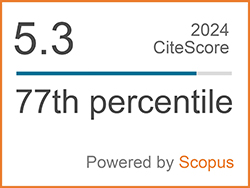A Study of Password Management Behaviors of Young People
Abstract
Keywords
[1] S. Boonkrong, “Methods and threats of authentication,” in Practical Cryptography Methods and Tools. Berkeley, California: Apress, 2021, pp. 45–70.
[2] NordPass, “Top 200 most common passwords of the year 2020,” 2021. [Online]. Available: https:// nordpass.com/most-common-passwords-list/
[3] D. Malone and K. Maher, “Investigating the distribution of password choices,” in The 21st International Conference on World Wide Web, 2012, pp. 301–310.
[4] Computer Emergency Response Team (CERT), “IN98.03: Password cracking activity,” Software Engineering Institute, Carnegie Mellon University, USA, 1998.
[5] Imperva, “Consumer password worst practices,” The Imperva Application Defence Center (ADC), USA, 2014.
[6] C. Shu, “Passwords for 32M twitter accounts may have been hacked and leaked,” 2021. [Online]. Available: https://techcrunch.com/2016/06/08/ twitter-hack/
[7] R. Shay, S. Komanduri, A. Suriti, P. Huh, M. L. Mazurek, S. Segreti, B. Ur, L. Bauer, N. Christin, and L. F. Cranor, “Designing Password policies for strength and usability,” ACM Transactions on Information and System Security, vol. 18, no. 4, pp. 1–34, 2016.
[8] S. Komanduri, R. Shay, P. G. Kelly, M. L. Mazurek, L. Bauer, N. Christin, L. F. Cranor, and S. Egelman, “Of passwords and people: Measuring the effect of password-composition policies,” in The SIGCHI Conference on Human Factors in Computing Systems, 2011, pp. 2595–2604. [9] H. Ray, F. Wolf, R. Kuber, and A. J. Aviv, “Why older adults (don't) use password managers,” in The USENIX Security Symposium, 2021, pp. 73–90.
[10] H. Y. Huang and M. Bashir, “Surfing safely: Examining older adults’ online privacy protection behaviors,” in The Association for Information Science and Technology, vol. 15, pp. 188–197, 2018.
[11] World Health Organisation (WHO), Young People’s Health - A Challenge for Society. Geneva, Switzerland: World Health Organisation, 1986.
[12] H. Habib, P. Emani-Naeini, S. Devlin, M. Oates, C. Swoopes, L. Bauer, N. Christin, and L. F. Cranor, “User behaviors and attitudes under password expiration policies,” in The Fourteenth USENIX Conference on Usable Privacy and Security, 2018, pp. 13–30.
[13] T. Hussain, K. Atta, N. Z. Bawany, and T. Qamar, “Password and user behavior,” Journal of Computers, vol. 13, no. 6, pp. 692–704, 2017.
[14] D. T. Fredericks, L. A. Futcher, and K. L. Thomson, “Comparing student password knowledge and behaviour: A case study,” in The Tenth International Symposium on Human Aspects of Information Security & Assurance (HAISA 2016), 2016, pp. 167–178.
[15] K. Bryant and J. Campbell, “User behaviours associated with password security and management,” Australasian Journal of Information Systems, vol. 14, no. 1, pp. 80–100, 2006.
[16] C. E. Shannon, “A mathematical theory of communication,” The Bell System Technical Journal, vol. 27, no. 3, pp. 379–423, 1948.
[17] W. Ma, J. Campbell, D. Tran, and D. Kleeman, “Password entropy and password quality,” in The Fourth International Conference on Network and System Security, 2010, doi: 10.1109/ NSS.2010.18.
[18] D. Florêncio and C. Herley, “Where do security policies come from?,” in The Sixth Symposium on Usable Privacy and Security, 2010, pp. 1–14.
[19] S. Pearman, J. Thomas, P. Emani-Naeini, H. Habib, L. Bauer, N. Christin, L. F. Cranor, S. Egelman, and A. Forget, “Let's go in for a closer look: Observing passwords in their natural habitat,” in The 2017 ACM SIGSAC Conference on Computer and Communications Security, 2017, pp. 295–310.
[20] B. Grawemeyer and H. Johnson, “Using and managing multiple passwords: A week to a view,” Interacting with Computers, vol. 23, no. 3, pp. 256–267, 2011.
[21] E. Stobert and R. Biddle, “The password life cycle: User behaviour in managing passwords,” in The Tenth USENIX Conference on Usable Privacy and Security, 2014, pp. 243–255.
[22] A. Das, J. Bonneau, M. Caesar, N. Borisov, and X. Wang, “The tangled web of password reuse,” in 2014 Network and Distributed System Security (NDSS) Symposium, 2014, pp. 23–26.
[23] University of Illinois, “Why you should use different passwords,” 2021. [Online]. Available: https://security.illinois.edu/content/why-youshould- use-different-passwords
[24] S. Bellovin, “Unconventional wisdom,” IEEE Security & Privacy, vol. 4, no. 1, p. 88, 2006.
[25] P. A. Grassi, J. L. Penton, E. M. Newton, R. A. Perlner, A. R. Regenscheid, W. E. Burr, J. P. Richer, N. B. Lefkovitz, J. M. Danker, Y. Y. Choong, K. K. Greene, and M. F. Theofanos, “NIST special publication 800-63B: Digital authentication guideline,” National Institute of Standards and Technology (NIST), USA, 2017.
[26] K. Helkala and T. H. Bakås, “Extended results of norwegian password security survey,” Information Management & Computer Security, vol. 22, no. 4, pp. 346–357, 2014.
[27] M. Theofanos, Y. Y. Choong, and O. Murphy, “Passwords keep me safe’ – Understanding what children think about passwords,” in The Thirtieth USENIX Security Symposium, 2021, pp. 19–35.
[28] B. Ur, F. Noma, J. Bees, S. M. Segreti, R. Shay, L. Bauer, N. Christin, and L. F. Cranor, “I added ‘!’ at the end to make it secure: Observing password creation in the lab,” in The Eleventh USENIX Conference on Usable Privacy and Security, 2015, pp. 123–140.
[29] Y. Y. Choong, M. F. Theofanos, and H. K. Liu, “NISTIR 7991: United States federal employees’ password management behaviors - A department of commerce,” National Institute of Standards and Technology (NIST), USA, 2014.
[30] L. Ion, R. Reeder, and S. Consolvo, “No one can hack my mind: Comparing expert and non-expert security practices,” in The Eleventh USENIX Conference on Usable Privacy and Security, 2015, pp. 327–346.
[31] A. Barron, Inference for Categorical Data, Introduction to Statistics. USA: Yale University, 1997.
DOI: 10.14416/j.asep.2023.01.001
Refbacks
- There are currently no refbacks.
 Applied Science and Engineering Progress
Applied Science and Engineering Progress







